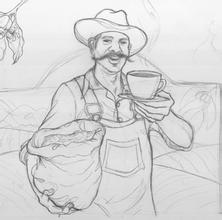The birth history of coffee roaster-Starbucks Italian roasted coffee beans
The birth history of coffee roaster-Starbucks Italian roasted coffee beans
The emergence of large roasters has changed people's own baking habits. Buying packaged baked beans or coffee powder to cook directly at home facilitates the fast-paced life of modern people. In the 1960s, brand-packaged coffee beans dominated the market. But there are also problems with mass baking: raw beans of average quality, excessive shallow roasting in order to maintain weight, lack of freshness causing flavor indeed. Since the 1980s, a "boutique coffee" movement was launched in the United States. It advocates people to buy boutique raw beans, home baking, drink fresh coffee, pursue quality and taste, and home roasting begins to be valued again. The pursuit of coffee quality also forced some big roasters to adopt higher quality beans to ensure baking quality in the middle and late 19th century, with the advent of large roasting machines, large quantities of roasted beans became possible. After the advent of the large roaster, after continuous innovation, electronically controlled precision instruments appeared in the first half of the 20th century, and the machine that could continuously bake 5000kg every hour in the 18th century. After coffee was introduced into Europe, Europeans also followed the Turkish-style practice of stir-frying coffee to black. Later, because of geographical and cultural differences, Europe was divided into shallow baking schools dominated by northern Europe, Germany, England and Scandinavia, and deep baking schools dominated by southern Europe. The former usually bake the beans to city-full city, while the latter generally bake them to the same depth as italy,french. Until the mid-19th century, most of Europe used iron pots or ovens to bake beans at home, and later invented small roasters that use closed iron buckets instead of iron pans and put them on the fire, and can bake a few pounds of beans at the same time. Adopted by some coffee shops as early as the 13th century, the Arabs invented coffee beans in pots, heated and fried, then ground into powder, and then brewed into coffee. Early Arabs like to bake beans shallowly and boil them with spices such as cardamom. Later, this method of coffee stir-frying spread to Syria, Turkey and Egypt, where it was used to stir-fry the coffee black, then grind it into powder, add sugar and boil it in water, pour it directly into a small cup and drink it with coffee grounds.
1. Definition of roasting: the so-called coffee roasting (coffee roasting) refers to the heating of raw beans, which promotes a series of physical and chemical reactions inside and outside the coffee beans, and in this process produces a variety of sour, bitter, sweet and other flavors of coffee, forming mellowness and hue, and converting raw beans into dark brown beans.
two。 The importance of baking: among the factors affecting the taste of a cup of coffee, raw beans account for 60%, roasting accounts for 30%, and extraction accounts for 10%. Good roasting can maximize the personality of raw beans and minimize the occurrence of defective flavor, on the contrary, improper roasting will completely destroy good beans. Due to heating in the baking process, time, temperature control is very difficult to grasp, baking technology is a very complex technology, so the importance of baking appears to be more prominent!

Important Notice :
前街咖啡 FrontStreet Coffee has moved to new addredd:
FrontStreet Coffee Address: 315,Donghua East Road,GuangZhou
Tel:020 38364473
- Prev

Is drinking coffee definitely refreshing? the refreshing effect of drinking coffee varies from person to person.
1. Age factor: there are fewer and fewer receptors in the brain that can dock with caffeine as you get older. The receptor in the brain of a 60-year-old is less than 1/3 of that of a 20-year-old, so the effect of coffee on the elderly is often compared.
- Next

Introduction to the Baking degree, Flavor description and Grinding scale of Yega Xuefei Coffee beans with strong Flavor
1) grind the powder according to the thickness of the hand 2) brew with hot water of about 83-85 degrees, the ratio of powder to water is 1:15-17, and the brewing time should not be too long. 3) put the hot coffee liquid into the refrigerator and refrigerate this way is actually putting the hand-brewed coffee liquid into the refrigerator to refrigerate and drink, which is not much different from the first method, and does not need to be refrigerated for too long.
Related
- Beginners will see the "Coffee pull flower" guide!
- What is the difference between ice blog purified milk and ordinary milk coffee?
- Why is the Philippines the largest producer of crops in Liberia?
- For coffee extraction, should the fine powder be retained?
- How does extracted espresso fill pressed powder? How much strength does it take to press the powder?
- How to make jasmine cold extract coffee? Is the jasmine + latte good?
- Will this little toy really make the coffee taste better? How does Lily Drip affect coffee extraction?
- Will the action of slapping the filter cup also affect coffee extraction?
- What's the difference between powder-to-water ratio and powder-to-liquid ratio?
- What is the Ethiopian local species? What does it have to do with Heirloom native species?

